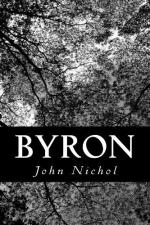Scott’s letter, in which a generous recognition of the pleasure he had derived from tho work of the English poet, was followed by a manly remonstrance on the subject of the attack in the Bards and Reviewers, drew from Byron in the following month (July 1812) an answer in the same strain, descanting on the Prince’s praises of the Lay and Marmion, and candidly apologizing for the “evil works of his nonage.” “The satire,” he remarks, “was written when I was very young and very angry, and fully bent on displaying my wrath and my wit; and now I am haunted by the ghosts of my wholesale assertions.” This, in turn, called forth another letter to Byron eager for more of his verses, with a cordial invitation to Abbotsford on the ground of Scotland’s maternal claim on him, and asking for information about Pegasus and Parnassus. After this the correspondence continues with greater freedom, and the same display on either side of mutual respect. When Scott says “the Giaour is praised among our mountains,” and Byron returns “Waverley is the best novel I have read,” there is no suspicion of flattery—it is the interchange of compliments between men,
Et cantare pares et respondere parati.
They talk in just the same manner to third parties. “I gave over writing romances,” says the elder, in the spirit of a great-hearted gentleman,” because Byron beat me. He hits the mark, where I don’t even pretend to fledge my arrow. He has access to a stream of sentiment unknown to me.” The younger, on the other hand, deprecates the comparisons that were being invidiously drawn between them. He presents his copy of the Giaour to Scott, with the phrase “To the monarch of Parnassus,” and compares the feeling of those who cavilled at his fame to that of the Athenians towards Aristides. From those sentiments, he never swerves, recognizing to the last the breadth of character of the most generous of his critics, and referring to him, during his later years in Italy, as the Wizard and the Ariosto of the North. A meeting was at length arranged between them. Scott looked forward to it with anxious interest, humorously remarking that Byron should say,—
Art thou the man whom men famed Grissell call?
And he reply—
Art thou the still more famed Tom Thumb the small?
They met in London during the spring of 1815. The following sentences are from Sir Walter’s account of it:—“Report had prepared me to meet a man of peculiar habits and quick temper, and I had some doubts whether we were likely to suit each other in society. I was most agreeably disappointed in this respect. I found Lord Byron in the highest degree courteous, and even kind. We met for an hour or two almost daily in Mr. Murray’s drawing-room, and found a great deal to say to each other. Our sentiments agreed a good deal, except upon the subjects of religion and politics, upon neither of which I




